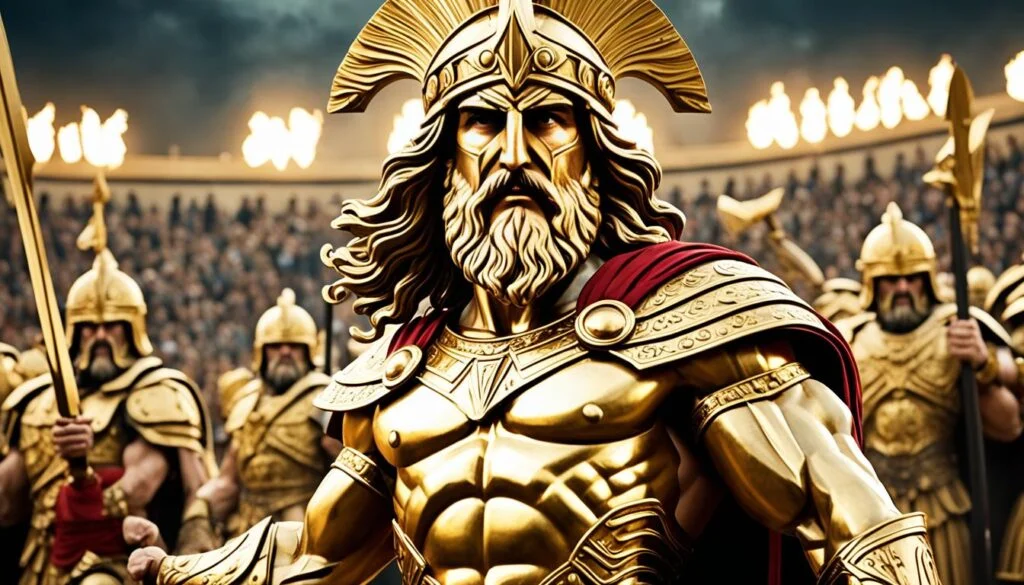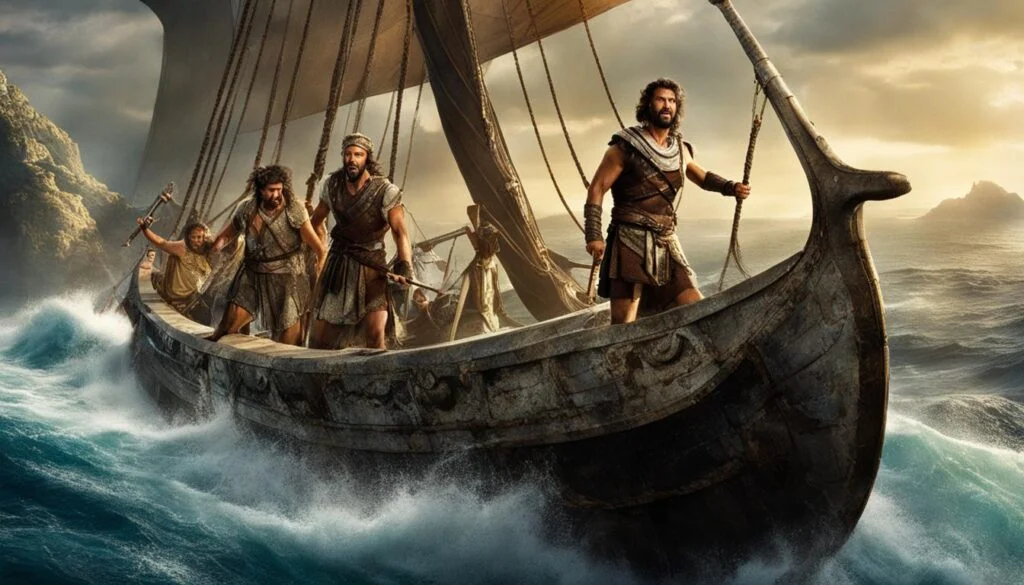Out of Greek mythology steps the great Agamemnon. He was not only the king of Mycenae but also the famous leader in the Trojan War.
Born into the cursed House of Atreus, Agamemnon’s story is layered with the gods’ influence.
As a key leader in the Trojan War, his actions became legendary over the war’s ten years.
The Agamemnon biography tells of his strength, the sacrifices he made, and the tragic end he met.
He ordered his daughter’s sacrifice and faced betrayal upon returning home. Despite his turbulent life, he’s a central Greek mythology figure. His story is told by Homer and lives on in the ruins of Mycenae.
Agamemnon and Clytemnestra had four children. This connection is vital in myths, often hinting at tragic destinies.
He led a massive army of 150,000, which included heroes like Achilles. Their tales are deeply connected through the Iliad.
Key Takeaways
- Trojan War led by Agamemnon spanned a decade.
- A complex biography weaves together familial tragedy with kingly duties.
- Agamemnon’s military might was reflected in his supremacy over a vast Greek army.
- The king’s return and murder highlight the vulnerability of Greek heroes despite their might.
- Agamemnon’s image looms large over Greek mythology, symbolizing both the glory and the doom inherent to heroism.
- His story continues to resonate, illustrating the timeless nature of myth in human culture.
Unraveling the Myth of Agamemnon
In Greek mythology, Agamemnon, king of Mycenae, stands out. His legend combines both glory and tragedy, fitting perfectly into myth’s rich tapestry.
His story shows the history of the House of Atreus, with its heroic parts and tragic losses.
Introduction to Greek Mythology’s Storied Monarch
To truly understand who was Agamemnon, we need to explore myth and history’s blending point.
As Mycenae’s ruler, Agamemnon was stuck in a cycle of family curses and predicted downfall. Remembered for the height of Mycenaean power, his reign was always shadowed by his family’s dark past.
Agamemnon’s Ancestral Curse and Royal Lineage
The family curse started long before Agamemnon, with his great-grandfather Tantalus.
His grandfather Pelops added to this legacy, causing family drama that led to large tragedies.
Agamemnon’s dad, Atreus, also did terrible things, making their family story full of suffering.
This setting made Agamemnon’s rule full of challenges, even though he did great things.
Dissecting the King’s Namesake: ‘Very Steadfast’
The name Agamemnon means ‘very steadfast’ in ancient Greek. This perfectly describes his character; he was determined and strong, qualities essential for leading in the Trojan War.
Despite his family’s cursed past, Agamemnon’s courage and smart decisions made him a key figure in Greek mythology.
His story weaves through ancient history, linking closely with the Agamemnon legend.
Agamemnon’s Early Life and Kingship
Agamemnon comes from the renowned Agamemnon family in Greek mythology. He was the son of King Atreus and Queen Aerope.
This put him in the middle of power struggles and epic tales.
His life story is filled with a royal legacy and a destined future. These elements shaped Agamemnon’s journey through Greek mythology.
The House of Atreus and the Throne of Mycenae
The famous House of Atreus marked Agamemnon’s early days. This house was known for its tragic past.
After his father’s murder, Agamemnon and Menelaus were forced to flee.
They found safety with the King of Sparta. This time outside was key in making Agamemnon a great leader and strategist.
He became known as a wise and eloquent king.
Marriage to Clytemnestra and Familial Tensions
Agamemnon’s marriage to Clytemnestra brought both joy and problems. They had four children together. Each child played a big part in their story.
His life was as difficult at home as it was in battle. This difficult time foreshadowed the tragic end of his family line.
The Infamous Abduction of Helen and the Onset of War
Fate and ambition came together, starting one of Greek mythology’s most thrilling tales. Helen of Troy, known for her beauty, was taken by Paris, a prince of Troy.
This event led to the start of the Trojan War.
At the heart of it all was Agamemnon. He was a crucial Trojan War leader
Agamemnon acted quickly and firmly when he heard the news. As the king of Mycenae, he was a key player in Greek leadership.
He reminded the princes about their promise to protect Helen’s marriage, a vow that linked them closely to Agamemnon’s kin.
He then gathered a massive army to bring Helen back and show Greek power. This gathering showed Agamemnon’s strength and his ability to lead different Greek groups.
It marked a turning point in his story, showing his skill and power before the Trojan War.
Paris taking Helen sparked a 10-year fight against Troy. This event showed how small arguments could lead to large wars.
Agamemnon’s actions during this were a mix of success and errors. This mix makes his tale more interesting than Greek stories.
In the end, the Greeks won using a clever trick, not just force. This victory shows that war needs both strength and wit.
Helen’s story and the following war show a lot about Agamemnon’s leadership. It also highlights the balance between personal goals and duty in ancient Greece.
Led by Agamemnon: United Greek Forces against Troy
Agamemnon, the strong king of Mycenae, spearheaded the Trojan War, lasting ten years. This battle became a defining moment in Greek history and myths.
As a leader, Agamemnon showed both clever tactics and made hard personal choices.
Mobilizing the Achaean Army and the Hundred Ships
With more than a thousand ships, Agamemnon led the Greeks from Greece’s shores to Troy’s walls.
This feat showcased his mastery of the Greek forces and established him as a key Greek mythology figure.
By bringing different city-states together, he proved his power and earned respect all around, even beyond Mycenae.
The Sacrifice of Iphigenia: Appeasing Artemis
Yet, the Greek fleet faced a divine obstacle in Aulis – Artemis sent still winds. Agamemnon was forced to make a tough choice.
He chose to sacrifice his daughter, Iphigenia, to please the goddess.
This act was a dark but necessary moment in Agamemnon’s history, showing the heavy decisions of war leadership.
It tells us a lot about the struggles leaders face.
Agamemnon opposed Troy, dealing not just with outside foes but also tough ethical dilemmas. His actions would influence Mycenae’s future and model the tragic hero in Greek tales.
Agamemnon in the Iliad: His Role and Relationship with Achilles
Agamemnon in the Iliad shows how hard it is to lead in war and be a good king. He battles these challenges in the Trojan War.
Agamemnon’s leadership and his fights with Achilles show how personal and national issues mix. His choices define the war’s path in Greek myth.
Agamemnon’s Quarrel with Achilles and its Ramifications
In the Iliad, Agamemnon and Achilles fight over Briseis, a woman Achilles loves. This fight weakens the Greeks and affects their war effort.
Agamemnon’s choice to take Briseis from Achilles looks bad. It shows Agamemnon’s bad decisions can be due to his feelings and need for power.
The King’s Bravery and Military Skills in the Trojan War
Even with his issues, Agamemnon is a skilled leader in the Trojan War. He shows his bravery and smartness in battles.
Agamemnon fights hard against the Trojans, proving he is a strong king and warrior.
His braveness and skills prove his importance in Greek warfare and his loyalty to his country.
Agamemnon is a complex character, showing both strong leadership and deep personal flaws.
He is key in studying ancient leadership and the sadness that comes with power in myths.
King Agamemnon’s Strategic Maneuvers and Battle Tactics
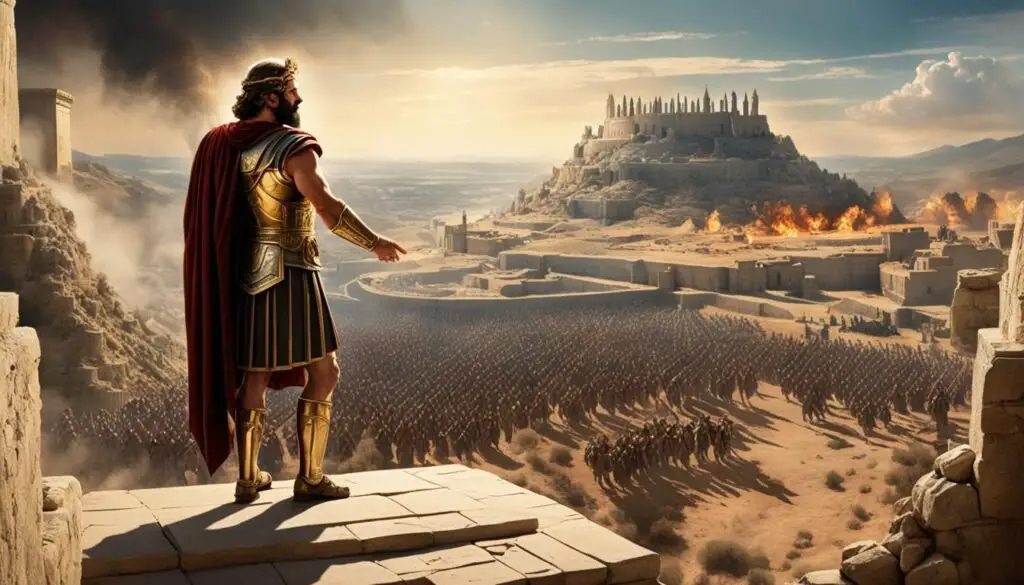
As a key Trojan War leader and a central Greek mythology figure, Agamemnon was crucial in the Greeks’ siege of Troy.
His talent showed in uniting Greek forces against Troy. This unity helped them carry out the war’s many complex tasks over ten years.
Agamemnon history praises his use of ships, which helped maintain the ten-year siege.
His leadership in military logistics and keeping his allies happy was impressive. It showed he understood the challenges of war well.
Agamemnon’s use of the Trojan Horse was a brilliant, sneaky move. It led to Troy’s fall and praised his clever strategy.
This tactic made him famous as a shrewd Greek mythology figure.
- Unified command of diverse Greek city-states
- Strategic naval blockade to cut off Trojan supplies
- Effective use of intelligence and subterfuge with the Trojan Horse
In the end, King Agamemnon stood out as a Trojan War leader. His smart and well-thought-out moves helped the Greek forces win.
Who was Agamemnon: The King’s Characteristics and Reputation
The story of Agamemnon shows us leadership in Greek mythology. He faced many challenges and his story is full of twists of fate and gods’ actions.
This made Agamemnon a complex and intriguing character.
Comparison with Other Greek Heroes and Leaders
Agamemnon played a key role in the Trojan War. He was known for his pride and leadership, which was as important as his bravery.
His ambition often led to conflict, setting him apart from other famous heroes.
Assessment of Agamemnon’s Command in the Trojan War
Agamemnon led the Greek forces in the Trojan War. His decisions sometimes lacked careful planning, causing issues.
Notably, the sacrifice of his daughter and the conflict with Achilles highlight his challenging leadership.
The Tragic Return of Agamemnon: Betrayal at Home
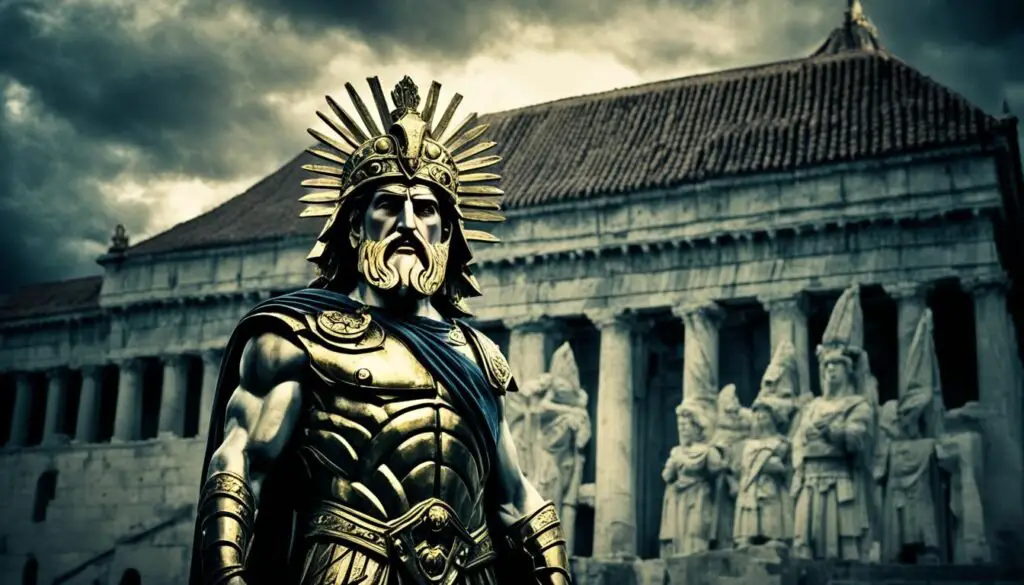
After the Trojan War ended, Agamemnon faced a bitter homecoming. He was met with betrayal and murder.
This unfortunate tale reveals the darkness that often shadows Agamemnon.
His return should have been joyful, but it ended in tragedy. His homecoming revealed the depth of his family’s sorrows.
Agamemnon was gone from home for ten years. His wife, Clytemnestra, harbored deep anger because of his long absence.
When he finally returned to Mycenae, she welcomed him with a blood-red carpet.
This act was a bad omen in Greek culture, symbolizing revenge. It led to Agamemnon’s murder by Clytemnestra and her lover, Aegisthus.
This event marked the start of a tragic period for Agamemnon’s family.
The Fate of Agamemnon: Clytemnestra’s Revenge
Clytemnestra could not forgive Agamemnon for Iphigenia’s sacrifice. This act aimed to gain favor from Artemis and a fair wind to Troy.
The family was deeply affected by this tragedy.
Her act of vengeance was also against Agamemnon for his affair with Cassandra. Clytemnestra’s motives were torn between avenging her daughter’s death and her husband’s infidelity.
The Continuation of the Curse: Orestes’ Vengeance
After Agamemnon’s murder, the family curse continued through Orestes. Orestes, upon discovering his father’s death, sought vengeance.
He killed his mother and her lover, keeping the cycle of revenge alive.
This curse tied the family to a long history of murder and retribution. The Agamemnon myth shows how tragedy remains part of their fates.
This narrative reveals a world of ongoing violence and betrayal. The Agamemnon story not only mourns his biography but also portrays the unyielding force of fate and curse in Greek mythology.
The Trojan War’s Legacy and Agamemnon’s Role in Later Myths
The Trojan War leader, Agamemnon, plays a big part in Greek myths. His story marks the ancient tales with a profound impact.
Many stories after Homer have put a new light on Agamemnon. They show his true depth and complexity.
Post-Homeric Tales and Dramatic Adaptations of Agamemnon’s Story
Playwrights like Aeschylus and Euripides transformed Agamemnon’s legacy. They unveiled the human side of this Greek mythology figure.
Their work turned him from just a strong warrior into a deep, conflicted character. These changes kept his place as a key figure in classical stories, captivating new audiences.
The Evolution of Agamemnon’s Character in Classical Literature
Even today, Agamemnon stands as a study of power and human weakness. His character has evolved in literature over time.
This shows how myths change with culture. As a Trojan War leader, Agamemnon’s choices and deeds have been closely examined.
Writers and scholars continue to explore his legacy. They keep him central in Greek myth studies.
The sagacity and flaws of Agamemnon are well-known thanks to these myths. He remains a legendary figure in literature and beyond.
The ongoing retellings of the Trojan War’s story enhance its timeless appeal. Each new telling holds onto the story’s challenge and enchantment.
The Archaeological Agamemnon: Separating Fact from Fiction
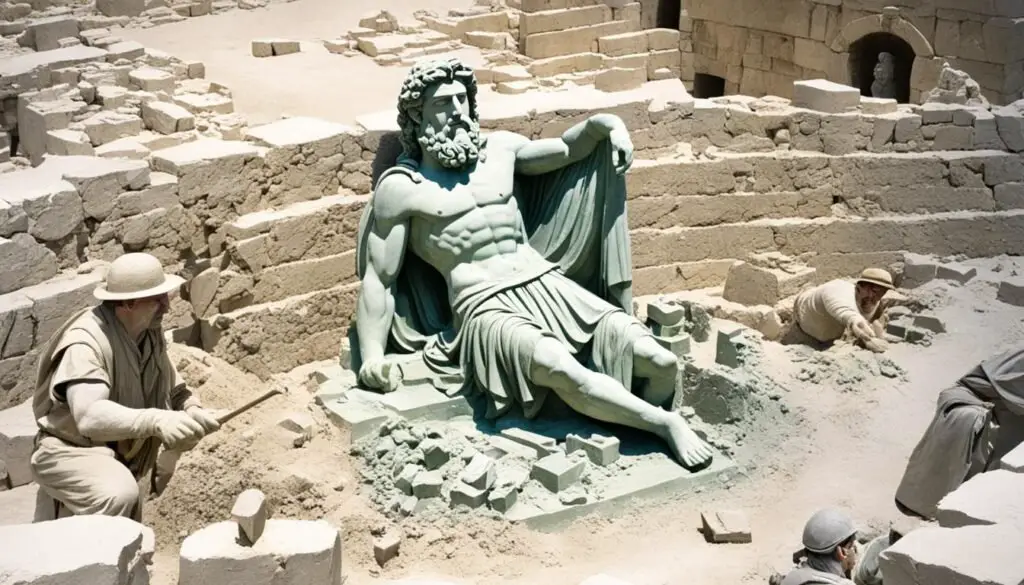
Agamemnon is a mysterious figure, known as the king of Mycenae. His existence as a real person is debated by experts.
They study ancient texts like the Iliad and findings from digs to figure out the truth.
Insights from Discoveries at Mycenae and the Mask of Agamemnon
The Mask of Agamemnon, found at Mycenae, is a symbol of ancient culture. Even though it dates earlier than Agamemnon’s time according to Homer, it’s still important.
It tells us a lot about how Mycenaeans buried their dead and their art.
The Historicity Debate: Was Agamemnon Real?
The debate about Agamemnon’s reality is a big mystery. Digging at places like Mycenae has found signs of a culture like the one ruled by Homeric kings.
Though we haven’t found direct proof of Agamemnon, these findings suggest a powerful ruler existed.
The mask and ruins might not prove Agamemnon was real. They do show us a time when stories of brave heroes were told.
This Agamemnon archaeology helps us explore both ancient lands and the tales of old Greece. It changes how we understand history through discoveries.
The Cultural Impact of Agamemnon’s Myth on Society
The story of Agamemnon, a main character in Greek mythology, has deeply affected how we see leaders, bravery, honor, and betrayal.
These themes are key in the stories of the Greeks’ heroics. They show the tug-of-war between fate, our choices, and the gods’ will.
These aspects are still important in how we think today.
Looking at Agamemnon’s life, we see a man dealing with a lot of social duties. His life has inspired a lot of art and books.
The way he led is often seen as both good and bad. This shows how power can have mixed results on morality.
- The story of Agamemnon needs us to understand ancient Greek society. There, personal and community honor decided who was seen as a hero and who wasn’t.
- Heroes of the time wanted to be remembered forever. They thought that dying in war was the best way to achieve that. Agamemnon’s tale, especially linked to the Trojan War, highlights this.
- Agamemnon’s tough choices, like his fights with Achilles, point out the heavy load that leadership can bring. Such stories remind us of the real challenges leaders face.
Finding Agamemnon’s tomb in Mycenae was a big discovery. It reinforced his place in history and reignited everyone’s interest in his story and the Mycenaean culture.
This find showed the mix of history and myth in his story. It also gave us a real look at the time when these hero tales came to be, shaping Western culture.
Agamemnon’s story is more than just old tales or a spot for tourists to visit. It’s used to explore what it means to be human.
His life shows us virtues, mistakes, and the results of his actions. These lessons from his life are still very useful today.
Agamemnon, as a complex figure in the Greek tales, keeps influencing our views on leadership and what’s right and wrong.
Examining Agamemnon’s Military Legacy and Influence
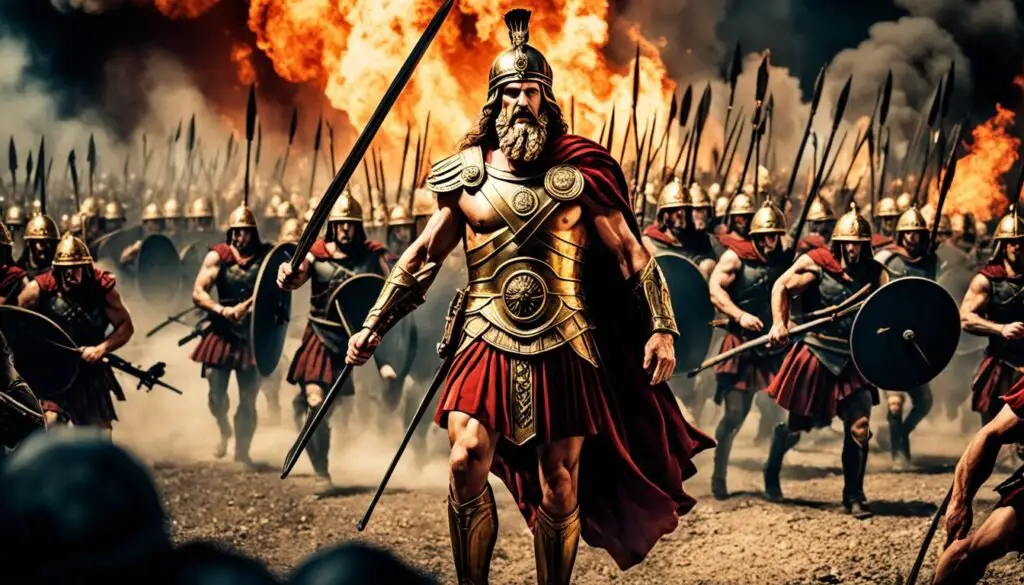
Agamemnon led the Trojan War, his influence is widely studied. He is known for his strong leadership in the war.
The tactics he used are still remembered and studied today.
His story shows us a lot about leading in war and tactics. We learn how he managed his troops and the difficult decisions he made.
Agamemnon’s story is rich in leadership lessons and the complexities of war.
Lessons from Agamemnon’s Leadership in War Strategy
Agamemnon faced tough leadership challenges during the Trojan War. His choices, like sacrificing Iphigenia and uniting Greek forces, showed his mix of strength and necessity.
These moves, though difficult, were crucial in securing his power.
His role in the Trojan War is filled with moral questions. Yet, it highlights the skillful leadership and strategy needed in war.
- The use of deception and psychological warfare, as evidenced by the false dream sent by Zeus, reveals Agamemnon’s understanding of the importance of morale in warfare.
- His ability to navigate through the near-mutiny of his forces further proves his adeptness in crisis management—a crucial lesson in sustaining military campaigns far from home.
Agamemnon’s Tactics and Their Relevance in Later Warfare
Agamemnon’s tactics at Troy have strongly influenced military leadership since. His methods, like managing alliances and strategic sacrifices, are still considered.
Even though his actions were from long ago, their core principles are still applied.
- The balancing act of leadership and personal emotions Agamemnon displayed is a scenario frequently revisited in military education, stressing the importance of emotional intelligence in leadership.
- The tactical retreats and advances orchestrated by Agamemnon during the Trojan War serve as early examples of conventional war tactics, which have been studied and refined in various military academies around the world.
Looking into Agamemnon’s history and his role in the Trojan War offers important lessons in leadership and military strategy.
His legacy is filled with victories and losses that still interest and teach us. He is remembered as a figure that combines history and myth, creating a unique tale of an ancient hero.
Conclusion
The story of Agamemnon goes far beyond ancient Mycenae’s ruins. It resonates through history, showing a legacy of courage, sadness, and the strong hand of fate.
Aeschylus’s changes to drama and Homer’s epic poems like The Iliad highlight Agamemnon’s lasting impact on the West’s culture.
As a mythological hero, his story makes us think about how the idea of being a hero changes. We also see the power struggle, a timeless issue.
Agamemnon faced the play of gods against human ambitions. His wife, Clytemnestra, played a key role in his downfall.
This shows a shift in power between men and women in ancient Greece. It also reflects their changing views on power and gender roles.
So, Agamemnon’s tale is not just about a king’s loss but also about the society of his time.
Agamemnon’s journey from Lydian royalty to the Trojan War, and his dramatic end are vivid through Aeschylus’s plays.
His influence ranges widely, from texts to discussions and music. Agamemnon remains a central figure in history and art today.
His story continues to interest and inspire discussions, weaving into our lasting cultural heritage.


